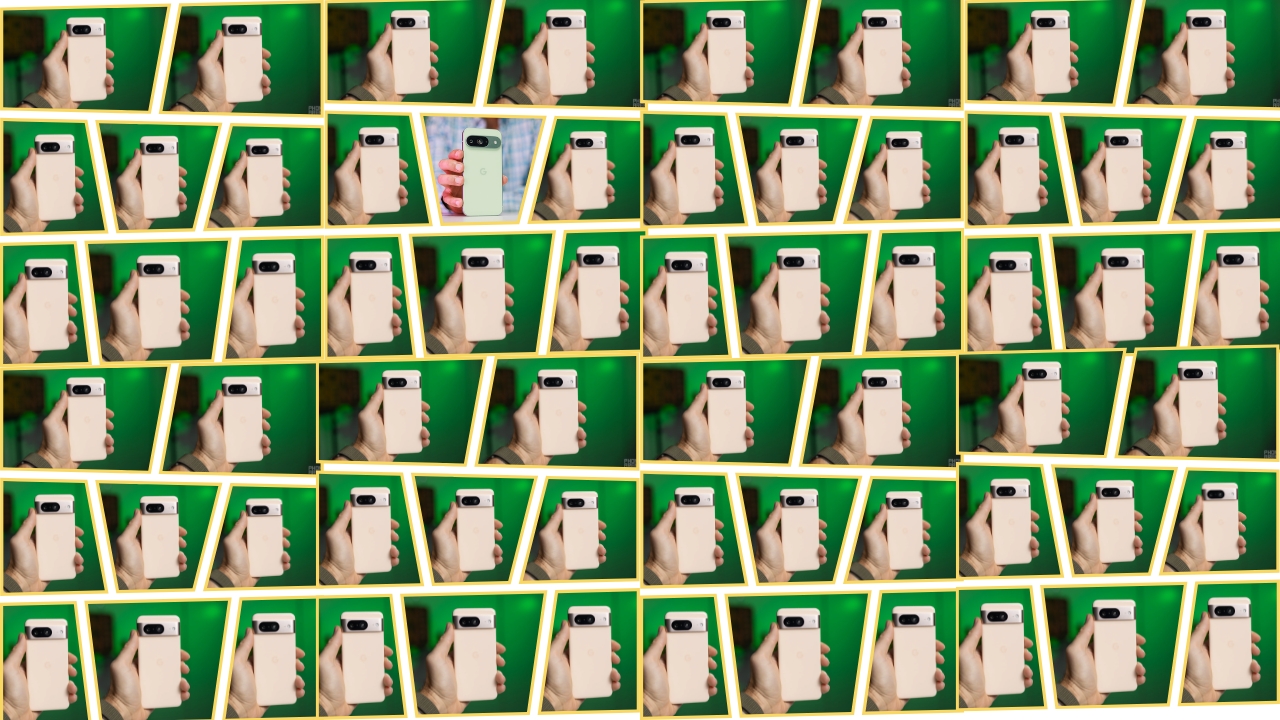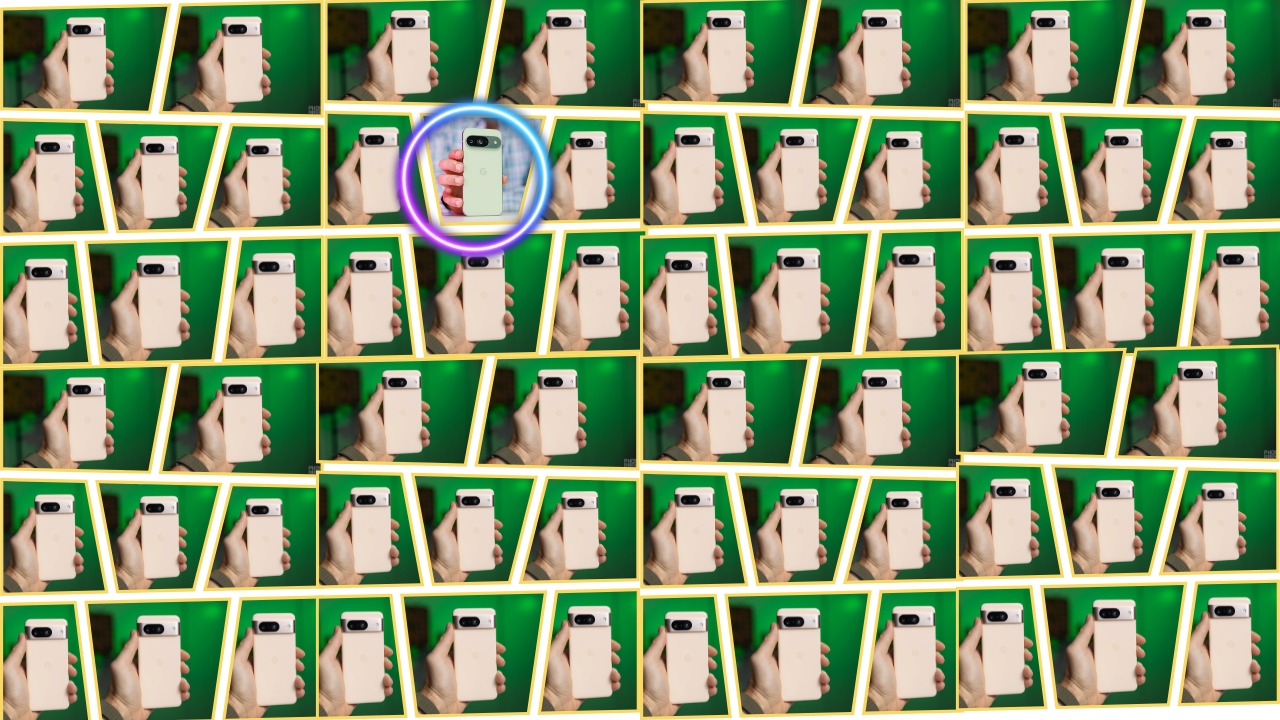Hidden Google Pixel 8 : Have you ever stared at one of those “find the hidden object” puzzles and felt your eyes practically burning from the effort? The challenge presented in these images—finding a Google Pixel 8 hidden among dozens of Google Pixel 9 devices—perfectly demonstrates how our brains process visual information and why these optical puzzles can be both frustrating and addictive.
Understanding How Your Visual System Works
When you first glance at these grid images, your brain immediately begins a complex process of pattern recognition. The visual cortex, located at the back of your brain, starts categorizing what it sees into familiar shapes and patterns. In this case, your brain quickly identifies “phone held by hand” as the dominant pattern and essentially creates a mental template.
This is where the challenge begins. Your brain becomes so focused on the repeating pattern that it starts to filter out subtle differences. It’s like your visual system puts on blinders, making it incredibly difficult to spot the one phone that’s actually showing its screen interface rather than just the plain back cover.
The phenomenon at work here is called “change blindness,” a psychological principle that explains why we often miss obvious changes in our visual field when our attention is focused elsewhere. Your brain assumes that since most of the grid contains identical images, they must all be the same.
Breaking Down the Pixel Challenge

Looking at these specific images, the task is to identify which phone is the Google Pixel 8 among the sea of Pixel 9 devices. The key difference lies in what’s displayed on the phone screen. While most phones in the grid show the characteristic back design of a phone case, the hidden Pixel 8 reveals its actual screen interface.
The circular highlight in the first image points to the solution, but imagine trying to find it without that helpful guide. Your eyes would naturally scan the grid, but the repetitive nature of the pattern creates a kind of visual noise that masks the differences.
This type of puzzle cleverly exploits something called “inattentional blindness.” When we’re actively searching for something specific, we often miss other obvious details right in front of us. The famous “invisible gorilla” experiment demonstrated this perfectly—participants counting basketball passes completely missed a person in a gorilla suit walking through the scene.
Why Four Seconds Makes It Extra Challenging
The four-second time limit isn’t arbitrary—it’s specifically chosen to pressure your visual processing system. Under normal circumstances, your brain would eventually notice the anomaly through systematic scanning. However, when you’re racing against time, your brain tends to rely more heavily on pattern recognition shortcuts.
These mental shortcuts, called heuristics, usually serve us well in daily life. They help us quickly identify familiar objects, navigate crowded spaces, and make rapid decisions. But in puzzles like this, these same shortcuts can work against us. Your brain says, “I see phones in hands, they’re all the same,” and moves on before conducting a thorough analysis.
The time pressure also triggers a stress response that can actually narrow your field of attention. This tunnel vision effect makes it even harder to spot subtle differences because your peripheral awareness decreases. It’s like trying to find a needle in a haystack while wearing glasses that only let you see a small circle at a time.
The Psychology Behind Visual Puzzles
What makes these challenges so compelling goes beyond simple entertainment. They tap into fundamental aspects of human psychology and cognition. When we successfully spot the hidden object, our brain releases a small burst of dopamine—the same neurotransmitter associated with rewards and achievements. This chemical response creates a sense of satisfaction and accomplishment.
The difficulty level is also crucial to engagement. If the puzzle were too easy, we’d feel bored. Too hard, and we’d feel frustrated and give up. These Pixel phone images hit that sweet spot where the challenge feels achievable but requires genuine effort and attention.
Social media has amplified the appeal of these puzzles because they create shareable moments. People love to test their friends, compare completion times, and debate whether they actually found the correct answer. This social element transforms a simple visual exercise into a competitive and communal experience.
Training Your Brain for Better Visual Detection
While these puzzles might seem like mere entertainment, they actually provide excellent exercise for your visual processing abilities. Regular engagement with spot-the-difference challenges can improve your attention to detail, pattern recognition skills, and ability to resist the influence of surrounding context.
Professional fields like radiology, quality control, and security screening rely heavily on these same visual detection skills. Radiologists searching for anomalies in medical scans face similar challenges to finding that hidden Pixel 8—they must spot subtle differences against complex, patterned backgrounds while maintaining accuracy under time pressure.
The Technology Connection
The choice of using Google Pixel phones in this illusion isn’t coincidental. These devices represent cutting-edge technology, yet the puzzle reduces them to simple visual elements in a pattern. This creates an interesting juxtaposition between our relationship with technology and our fundamental human perceptual limitations.
Despite having incredibly sophisticated devices in our pockets, our brains still operate using the same basic visual processing systems that evolved thousands of years ago. These ancient systems weren’t designed to handle the information-rich, pattern-heavy visual environments we encounter today, which is exactly why these modern optical illusions can be so challenging.
Optical Illusion Answer

The next time you encounter a “find the hidden object” puzzle, remember that your struggle isn’t a sign of poor observation skills—it’s a demonstration of how your remarkable brain processes visual information. These challenges reveal the elegant complexity of human perception while providing an entertaining way to exercise your cognitive abilities.
The hidden Google Pixel 8 in these images serves as more than just a puzzle solution; it represents a window into understanding how we see, process, and interpret the visual world around us. Whether you spotted it in four seconds or needed longer, you’ve participated in a fascinating exploration of human cognition disguised as a simple game.